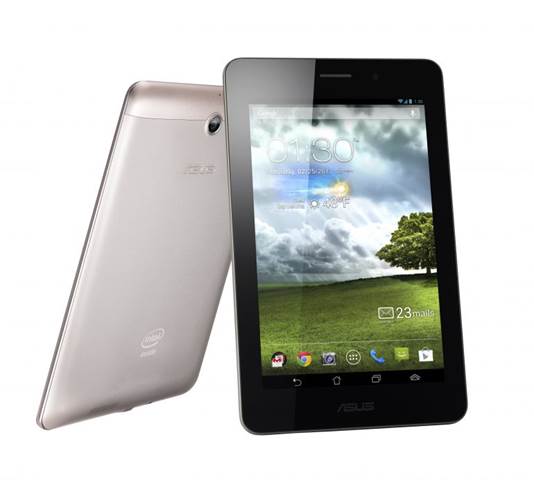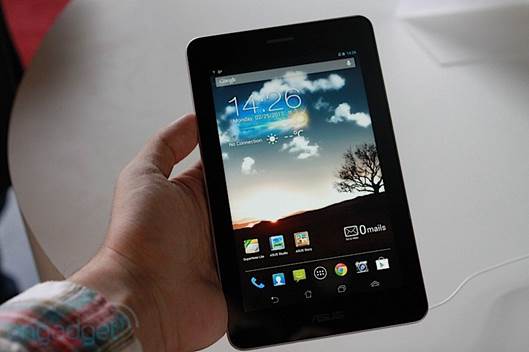A Tablet That Thinks It's A Very Big
Smartphone
It's easy to confuse the Asus Fonepad with
the similarly named Asus Padfone 2 . The latter is a
smartphone that docks with a 10in tablet, but the Fonepad is a 7in tablet that
can also be used as a giant smartphone.
Even if you don't feel silly holding the
Fonepad up to your ear, it's far too wide and ungainly to hold like a phone and
is best used with a Bluetooth headset or on speakerphone. It can also access
the internet using 3G mobile networks, which is a far more useful feature.

A
tablet that thinks it's a very big smartphone
The Fonepad looks similar To Asus's Nexus 7
tablet, but the rear is made out of metal rather than dimpled, soft-touch plastic.
Although we were worried this would make it prone to slipping out of our hands,
this wasn't a problem. It's a sturdy tablet with only slight creakiness around
the plastic tab, which has to be prized off to access the micro SIM and micro SD
memory card slots. Despite the metal build, the Fonepad weighs 340g, the same
as the Nexus 7.
What did turn out to be a problem was
something unexpected - performance. Simple tasks such as scrolling through
webpages and zooming in and out of maps and images proved sluggish. Quitting
apps running in the background only helped a little. Attempting to play
demanding 3D games proved frustrating because graphics lacked detail and motion
was juddery. We suspect the cause of this poor performance is the 1.2GHz single
core Intel Atom Z2420 processor. Originally designed for cheap
smartphones, it isn't as fast as previous Intel chips used in other Android
devices.

Originally
designed for cheap smartphones, it isn't as fast as previous Intel chips used
in other Android devices
This is a shame as the Fonepad is otherwise
a fine tablet. The 7in screen is bright with crisp text thanks to its
1280x800-pixel resolution. If you're not satisfied with the picture
quality of the screen, it can be adjusted using the screen settings app.
Like the Nexus 7 it doesn't have a
rear-facing camera, but it does have a forward-facing camera for video chats.
The 16GB storage is adequate, but more can be added using micro SD cards. At
least battery life is good. When playing videos continuously, it lasted just
under 11 hours. This isn't far off the battery life of the iPad Mini and Amazon
Kindle FireHD.
The Fonepad comes with Android 4.1 rather
than the latest 4.2 version, but the update should be available by the time you
read this. One of the most significant additions is a series of simple mini
apps, including a calculator, notepad and calendar, which float above regular
apps.

The
Fonepad comes with Android 4.1 rather than the latest 4.2 version, but the
update should be available by the time you read this
The Fonepad's ability to make phone calls
is a gimmick, but the device is one of the cheapest 3G-capable Android tablets
available. However, it's too slow to recommend. We'd much rather have a Nexus 7
which is now available with built-in 3G for only a few pounds more.
Our Verdict
A very cheap 3G Android tablet let down by
slow performance
Key points
Tablet can also be used as a phone • Sturdy
and classy build quality • Sluggish performance • Cheap • Built-in 3G
Alternative product
Asus Nexus 7
Price: $359
Although it's more expensive, Asus's own
Nexus 7 has better performance and is now available with built-in 3G.